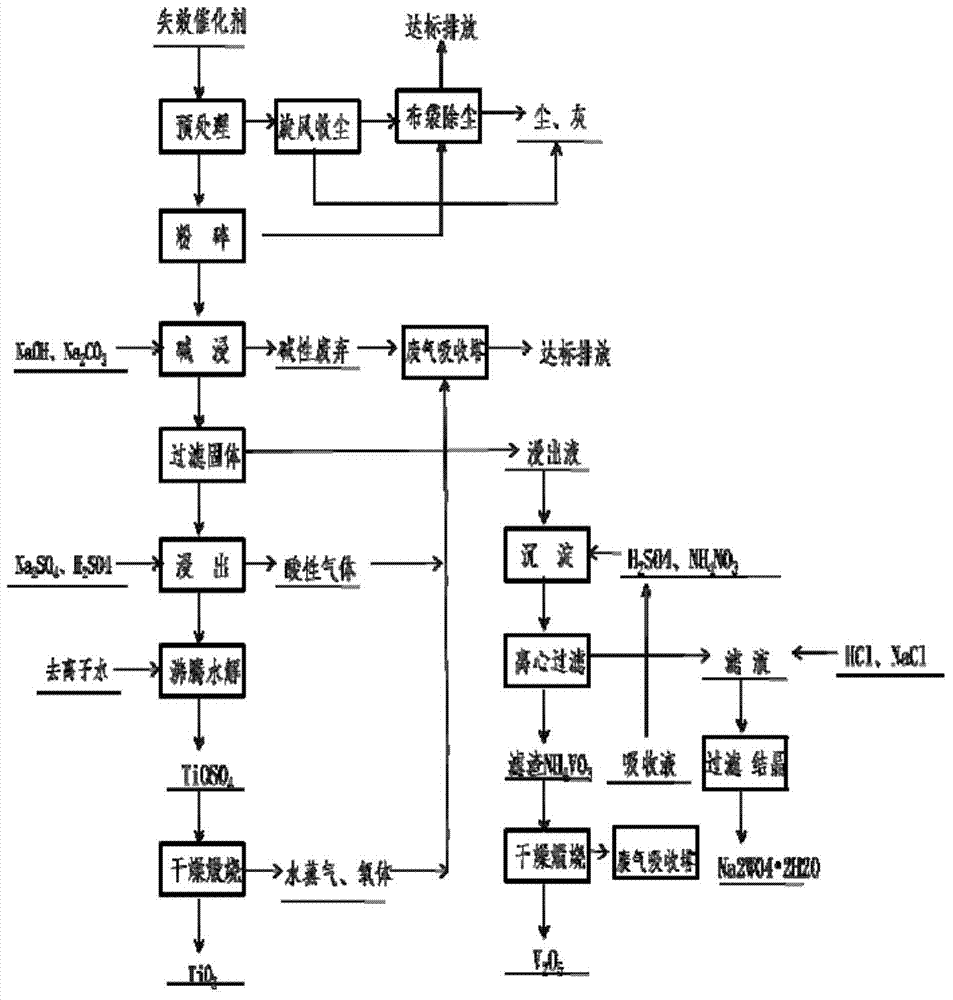Process for comprehensive recovery of metal-containing oxides in disabled SCR (selective catalytic reduction) denitration catalyst
A denitration catalyst and oxide technology, applied in the direction of improving process efficiency, can solve the problems of valuable metal resources failing to be recycled, occupying land resources, waste of effective resources, etc. Effect
- Summary
- Abstract
- Description
- Claims
- Application Information
AI Technical Summary
Problems solved by technology
Method used
Image
Examples
Embodiment 1
[0028] A comprehensive recovery process for metal oxides contained in spent SCR denitrification catalysts, the process flow is shown in figure 1 , the specific process is as follows:
[0029] 1. Raw material pretreatment: Take the invalid denitrification catalyst and wash it with ultrasonic and bubbling water to wash off the loads such as residual ash and soluble inorganic matter on the surface, put it into the electric furnace, and carry out high-temperature roasting at 650°C. Remove carbon deposits, arsenic and organic impurities that may be adsorbed on the surface, and keep the temperature constant for 4 hours.
[0030] 2. Pulverization: Add the denitrification catalyst after high-temperature roasting into a crusher, and pulverize it to a particle size of ≤200 μm to obtain a uniform powder.
[0031] 3. Sodium solution dissolution: Mix the powder obtained in the previous step with NaOH solution at a ratio of 1g:5ml for reaction, and the concentration of NaOH solution is 600...
Embodiment 2
[0037] 1. Raw material pretreatment: Take the invalid denitrification catalyst and wash it with ultrasonic and bubbling water to wash off the loads such as residual ash and soluble inorganic matter on the surface, put it into the electric furnace, and carry out high-temperature roasting at 650°C. Remove carbon deposits, arsenic and organic impurities that may be adsorbed on the surface, and keep the temperature constant for 4 hours.
[0038] 2. Pulverization: Add the denitrification catalyst after high-temperature roasting into a crusher, and pulverize it to a particle size of ≤200 μm to obtain a uniform powder.
[0039] 3. Dissolving in sodium solution: Mix the powder obtained in the previous step with NaOH solution at a ratio of 1g:6ml, and the concentration of NaOH solution is 500g / L. Add co-solvent Na to the mixture 2 CO 3 , the amount of co-solvent added is twice the mass of the powder, heated at a constant temperature at 100°C and stirred for 90 minutes to obtain a sol...
Embodiment 3
[0045] 1. Raw material pretreatment: Take the invalid denitrification catalyst and wash it with ultrasonic and bubbling water to wash off the loads such as residual ash and soluble inorganic matter on the surface, put it into the electric furnace, and carry out high-temperature roasting at 650°C. Remove carbon deposits, arsenic and organic impurities that may be adsorbed on the surface, and keep the temperature constant for 4 hours.
[0046] 2. Pulverization: Add the denitrification catalyst after high-temperature roasting into a crusher, and pulverize it to a particle size of ≤200 μm to obtain a uniform powder.
[0047] 3. Sodium solution dissolution: Mix the powder obtained in the previous step with NaOH solution at a ratio of 1g:4ml for reaction, and the concentration of NaOH solution is 400g / L. Add co-solvent Na to the mixture 2 CO 3 , the amount of co-solvent added is 3 times the mass of the powder, heated at a constant temperature at 80°C and stirred for 60 minutes to ...
PUM
 Login to View More
Login to View More Abstract
Description
Claims
Application Information
 Login to View More
Login to View More - R&D
- Intellectual Property
- Life Sciences
- Materials
- Tech Scout
- Unparalleled Data Quality
- Higher Quality Content
- 60% Fewer Hallucinations
Browse by: Latest US Patents, China's latest patents, Technical Efficacy Thesaurus, Application Domain, Technology Topic, Popular Technical Reports.
© 2025 PatSnap. All rights reserved.Legal|Privacy policy|Modern Slavery Act Transparency Statement|Sitemap|About US| Contact US: help@patsnap.com

